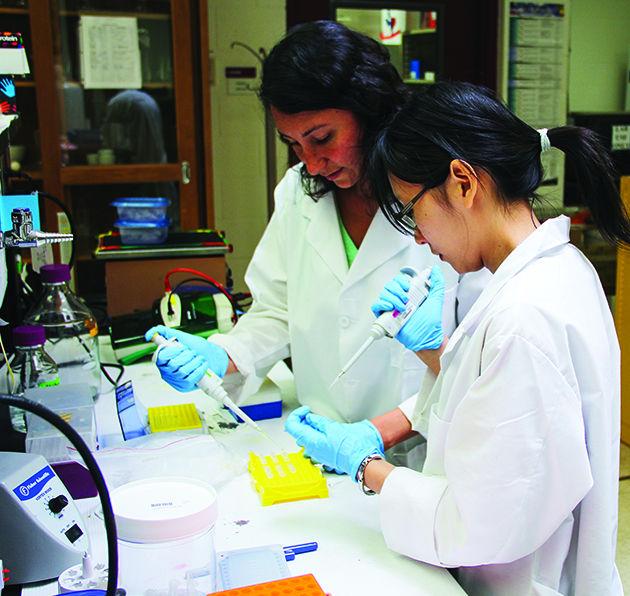Lifestyles writer Emily Thompson sat down with Dr. Luis Cisneros-Zevallos, associate professor of horticultural sciences, to discuss the nature of his research with bioactive compounds in stone fruits that could be used to fight chronic diseases, including cancer and diabetes.
THE BATTALION: In addition to studying cancer and diabetes, what does your research pertain to?
CISNEROS-ZEVALLOS: We have been working in the past few years on identifying chemical compounds from plants that could be used to prevent or fight chronic diseases that are of concern in our society, including cancer, using cell models for cancer, obesity, inflammation, diabetes and cardiovascular disease. As a result of this work, we have shown that stone fruits including peaches and plums have a range of bioactive compounds that can suppress breast cancer metastasis in vivo studies using mice. These same bioactive compounds may reverse insulin resistance in muscle and hepatic cells as well as glucose insensitivity in pancreatic cells, all of which are events that take place in a diabetes scenario. We have been working with a broad range of crops, both commercial U.S. crops like stone fruits and pecans as well as native crops from different centers of biodiversity including the Amazon, Andean region, Mexico and Indonesia. In addition to this, we are also interested in understanding how these chemical compounds are synthesized in the plants under different stress conditions. The ultimate goal here is to convert plants into bio-factories of compounds that can satisfy the demand of alternative high value health markets such as functional foods, dietary supplements, cosmetics and pharmaceuticals.
THE BATTALION: What sort of data have you gathered thus far? What might this data indicate?
CISNEROS-ZEVALLOS: Well, the hypothesis is that fruits, vegetables and grains contain a range of different categories of chemical compounds that when consumed, metabolized and absorbed, exert their biological effects in cells in different fronts simultaneously as well as through additive and synergistic effects. One way to prove this is to use molecular tools studying effects at the gene and protein expression level which allows us to identify the targeted pathways and their specific biological effects. Several of our studies on cancer and diabetes have allowed us to identify the molecular mechanism involved and the specific compounds that exert these effects. Once this is known, we can revalue crops and even initiate the search for new compounds.
THE BATTALION: What inspired you to do this research?
CISNEROS-ZEVALLOS: That is a good question. In part is the fact that for a scientist discovering new things nobody has seen before is very attractive and an important motivation to continue. On the other side is the fact that you have this idea that you are doing something that has the potential to help people, either if these are the growers that are trying to find new markets, consumers that are searching for healthier products and/or countries that are trying to revalue their crops.
THE BATTALION: Why do you feel that your research is relevant, particularly now?
CISNEROS-ZEVALLOS: We feel our research is very relevant because we have been able to assemble a group that conducts research in both drug discovery and plant biosynthesis in the same lab. This is very unique and perhaps we are the only group in the U.S. to be able to do so in the same group. We are proud of this fact. On the other hand I consider we are the only group on campus and likely in the U.S. to have extensive connections at the international level with unique access to different centers of plant biodiversity. This is the result of many years of work and networking which positions us to have unique relationships. For example, we have an agreement with EMBRAPA from Brazil (equivalent to the USDA) through their LABEX program which allows us to work exclusively with an array of native crops from Brazil. Our LABEX partner Dr. Ricardo Elesbao Alves has been in our group for the past 3 years and the intention is to keep this productive working relationship for many more years.
THE BATTALION: What are some of the projects you’ve worked on in the past to lead you to this particular study?
CISNEROS-ZEVALLOS: One of the first studies we performed some years ago with stone fruits including peaches and plums was to determine the antioxidant levels present in those fruits. After those initial studies, we observed very high levels even comparable to blueberries, which at the time were considered one of the highest among U.S. crops. By identifying the profiles of the bioactive compounds, we were able to propose that these fruits contained compounds that could prevent or fight diseases like breast cancer. Our most recent paper published last march in the Journal of Nutritional Biochemistry have confirmed in vivo studies that these suppress metastasis and that if we were able to translate those results to initiate clinical studies with people it would mean an average consumption of two to three peach fruit per day. That kind of work is very encouraging and we plan to continue with it.
Disease-fighting crops
June 26, 2014
Photo by Coby Franklin
Doctoral student Elisa Schreckinger and master’s student Fang-Mian Chang work
Donate to The Battalion
Your donation will support the student journalists of Texas A&M University - College Station. Your contribution will allow us to purchase equipment and cover our annual website hosting costs.




















